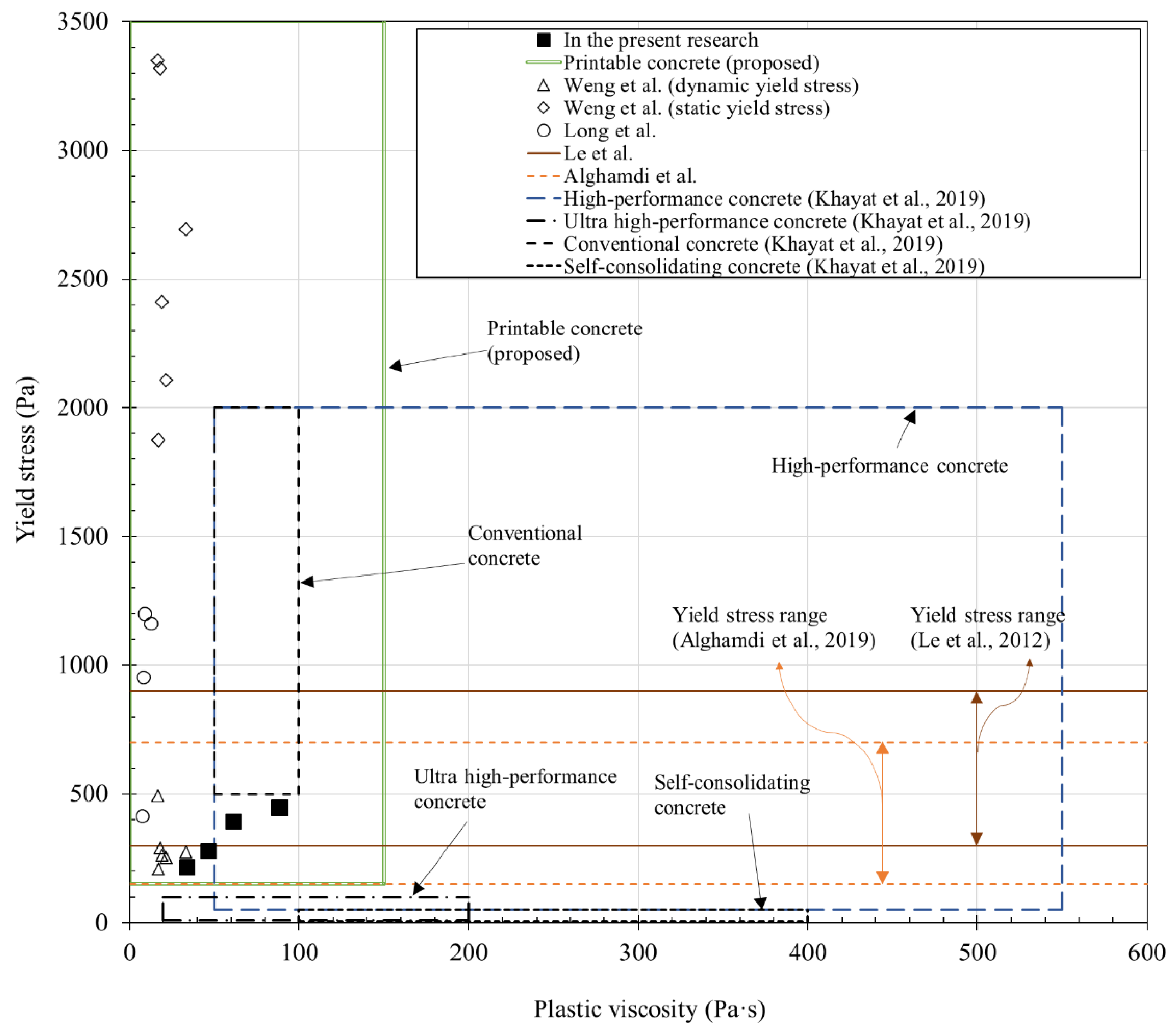Experimental Study on Time-Dependent Changes in Rheological Properties and Flow Rate of 3D Concrete Printing Materials
Abstract
:1. Introduction
2. Experimental Design for Pumpability Tests
2.1. Rheological Properties
2.2. Preparation for Pumpability Tests
2.3. Pumpability Test with Open Time
2.4. Layer Shape Measurements
3. Results and Discussion
3.1. Rheological Properties of 3DCP Materials
3.2. Flow Rate Change over Time
3.3. Layer Shape Measurements
3.4. Changes in Rheological Properties and Volume of Printed Layer
4. Conclusions
- The rheological properties that affect the flow rate tend to change with time. The yield stress and plastic viscosity continuously increased from immediately after mixing to 60 min and became almost twice. The yield stress increased from 213.4 Pa at 5 min up to 445.6 Pa at 60 min, and the plastic viscosity from 34.4 Pa∙s at 5 min up to 88.7 Pa∙s at 60 min. This confirms that the rheological properties are affected by time.
- A total of nine batches were used to measure the flow rate. As a result, it was confirmed that the extrusion amount decreased by about 0.3 g/s with time. At the start of extrusion, the measured amount was 8.69 kg, but after 1800 s, it became 8.24 kg. Considering that the unit measurement time is 90 s, the initial flow rate, which was 96.56 g/s, was reduced by about 5 g/s to 91.56 g/s at 1800 s. At 1800 s, the extrusion amount decreased by more than 5% to about 94.8% of the initial value.
- As for the measurement results of nine batches, a maximum of about 3 kg difference occurred in one measurement even under same material and extrusion conditions. This difference is expected to be due to the absorption rate of the aggregate based on the material properties alone. However, the decreasing trend of the extrusion amount with time showed a similar trend in all nine batches, thus it does not affect the flow characteristics of the material over time.
- The layer width was measured by printing 21 layers of a laminate having a length of 1000 mm, width of 2000 mm, and height of 10 mm. As a result of measuring the layer width, the layer width decreased as the number of layers increased. Through this, it was confirmed that the width of the layer decreased with time even under same conditions.
- Using the measured width of the layer, cross-sectional area, and volume of the layer, the weight of the output layer during one cycle were calculated, which was confirmed to be included in the range of flow rate results. The initial four cycles were higher than the average value of the flow rate measurement results, but after that, the results were almost similar, suggesting that the flow rate and the cross-sectional area of the layer are correlated.
- The volume of printed layer was compared using the measurement results of material yield stress and plastic viscosity, which affect the flow rate of the layer. It was confirmed that the two results showed similar trends. However, since the types of materials used in this study are limited for deriving an accurate correlation, additional research is needed.
Author Contributions
Funding
Institutional Review Board Statement
Informed Consent Statement
Conflicts of Interest
References
- Zhang, J.; Wang, J.; Dong, S.; Yu, X.; Han, B. A review of the current progress and application of 3D printed concrete. Compos. Part A 2019, 125, 105533. [Google Scholar] [CrossRef]
- Le, T.T.; Austin, S.A.; Lim, S.; Buswell, R.A.; Gibb, A.G.F.; Thorpe, T. Mix design and fresh properties for high-performance printing concrete. Mater. Struct. 2012, 45, 1221–1232. [Google Scholar] [CrossRef] [Green Version]
- Arunothayan, R.; Nematollahi, B.; Bong, S.H.; Ranade, R.; Sanjayan, J. Hardened Properties of 3D Printable Ultra-High Performance Fiber-Reinforced Concrete for Digital Construction Applications. In Rheology and Processing of Construction Materials; Springer: Berlin/Heidelberg, Germany, 2019; pp. 355–362. [Google Scholar]
- Sanjayan, J.G.; Jayathilakage, R.; Rajeev, P. Vibration induced active rheology control for 3D concrete printing. Cem. Concr. Res. 2021, 140, 106293. [Google Scholar] [CrossRef]
- Bao, Y.; Xu, M.; Soltan, D.; Xia, T.; Shih, A.; Clack, H.L.; Li, V.C. Three-dimensional printing multifunctional engineered cementitious composites (ECC) for structural elements. In Proceedings of the RILEM International Conference on Concrete and Digital Fabrication, Zurich, Switzerland, 9–12 September 2018; pp. 115–128. [Google Scholar]
- Wang, W.; Konstantinidis, N.; Austin, S.A.; Buswell, R.A.; Cavalaro, S.; Cecinia, D. Flexural Behaviour of AR-Glass Textile Reinforced 3D Printed Concrete Beams. In Proceedings of the Second RILEM International Conference on Concrete and Digital Fabrication, Eindhoven, The Netherlands, 6–9 July 2020; Springer: Cham, Switzerland, 2020; pp. 728–737. [Google Scholar]
- Ma, G.; Li, Z.; Wang, L.; Wang, F.; Sanjayan, J. Mechanical anisotropy of aligned fiber reinforced composite for extrusion-based 3D printing. Constr. Build. Mater. 2019, 202, 770–783. [Google Scholar] [CrossRef]
- Lee, H.; Kim, J.-H.J.; Moon, J.-H.; Kim, W.-W.; Seo, E.-A. Evaluation of the Mechanical Properties of a 3D-Printed Mortar. Materials 2019, 12, 4104. [Google Scholar] [CrossRef] [Green Version]
- Zhu, B.; Pan, J.; Nematollahi, B.; Zhou, Z.; Zhang, Y.; Sanjayan, J. Development of 3D printable engineered cementitious composites with ultra-high tensile ductility for digital construction. Mater. Des. 2019, 181, 108088. [Google Scholar] [CrossRef]
- Mechtcherine, V.; Nerella, V.N.; Will, F.; Näther, M.; Otto, J.; Krause, M. Large-scale digital concrete construction—CONPrint3D concept for on-site, monolithic 3D-printing. Autom. Constr. 2019, 107, 102933. [Google Scholar] [CrossRef]
- Suntharalingam, T.; Nagaratnam, B.; Poologanathan, K.; Hackney, P.; Ramli, J. Effect of Polypropylene Fibres on the Mechanical Properties of Extrudable Cementitious Material. In Proceedings of the Second RILEM International Conference on Concrete and Digital Fabrication, Eindhoven, The Netherlands, 6–9 July 2020; Springer: Cham, Switzerland, 2020; pp. 516–526. [Google Scholar]
- Rahul, A.V.; Santhanam, M. Evaluating the printability of concretes containing lightweight coarse aggregates. Cem. Concr. Compos. 2020, 109, 103570. [Google Scholar] [CrossRef]
- Rahul, A.V.; Santhanam, M.; Meena, H.; Ghani, Z. 3D printable concrete: Mixture design and test methods. Cem. Concr. Compos. 2019, 97, 13–23. [Google Scholar] [CrossRef]
- Xu, J.; Ding, L.; Cai, L.; Zhang, L.; Luo, H.; Qin, W. Volume-forming 3D concrete printing using a variable-size square nozzle. Autom. Constr. 2019, 104, 95–106. [Google Scholar] [CrossRef]
- Khalil, N.; Aouad, G.; El Cheikh, K.; Rémond, S. Use of calcium sulfoaluminate cements for setting control of 3D-printing mortars. Constr. Build. Mater. 2017, 157, 382–391. [Google Scholar] [CrossRef]
- Zhang, Y.; Zhang, Y.; She, W.; Yang, L.; Liu, G.; Yang, Y. Rheological and harden properties of the high-thixotropy 3D printing concrete. Constr. Build. Mater. 2019, 201, 278–285. [Google Scholar] [CrossRef]
- Yang, K.-H.; Hwang, H.-Z.; Lee, S. Effects of water-binder ratio and fine aggregate–total aggregate ratio on the properties of Hwangtoh-based alkali-activated concrete. J. Mater. Civil. Eng. 2010, 22, 887–896. [Google Scholar] [CrossRef]
- Cho, B.-S.; Ahn, J.-C.; Park, D.-C. Rheological evaluation of blast furnace slag cement paster over setting time. J. Korea Inst. Build. Constr. 2016, 16, 505–512. [Google Scholar] [CrossRef]
- Panda, B.; Paul, S.C.; Mohamed, N.A.N.; Tay, Y.W.D.; Tan, M.J. Measurement of tensile bond strength of 3D printed geopolymer mortar. Measurement 2018, 113, 108–116. [Google Scholar] [CrossRef]
- Jang, K.P.; Kwon, S.H.; Choi, M.S.; Kim, Y.J.; Park, C.K.; Shah, S.P. Experimental observation on variation of rheological properties during concrete pumping. Int. J. Concr. Struct. Mater. 2018, 12, 79. [Google Scholar] [CrossRef]
- Lee, H.; Kim, J.-H.J.; Moon, J.-H.; Kim, W.-W.; Seo, E.-A. Experimental analysis on rheological properties for control of concrete extrudability. Adv. Con. Const. 2020, 9, 93–102. [Google Scholar] [CrossRef]
- Feys, D.; Schutter, G.D.; Khayat, K.H.; Verhoeven, R. Changes in rheology of self-consolidating concrete induced by pumping. Mater. Struct. 2016, 49, 4657–4677. [Google Scholar] [CrossRef] [Green Version]
- Banfill, P.F.G. The rheology of fresh cement and concrete—A review. In Proceedings of the 11th International Congress on the Chemistry of Cement, Durban, South Africa, 11–16 May 2003. [Google Scholar]
- Banfill, P.F.G. Rheology of fresh cement and concrete. Rheol. Rev. 2006, 70, 61–130. [Google Scholar]
- Roussel, N. Rheological requirements for printable concretes. Cem. Concr. Res. 2018, 112, 76–85. [Google Scholar] [CrossRef]
- Khayat, K.H.; Meng, W.; Vallurupalli, K.; Teng, L. Rheological properties of ultra-high-performance concrete—An overview. Cem. Concr. Res. 2019, 124, 105828. [Google Scholar] [CrossRef]
- Long, W.-J.; Tao, J.-L.; Lin, C.; Gu, Y.-C.; Mei, L.; Duan, H.-B.; Xing, F. Rheology and buildability of sustainable cement-based composites containing micro-crystalline cellulose for 3D-printing. J. Clean. Prod. 2019, 239, 118054. [Google Scholar] [CrossRef]
- Weng, Y.; Lu, B.; Li, M.; Liu, Z.; Tan, M.J.; Qian, S. Empirical models to predict rheological properties of fiber reinforced cementitious composites for 3D printing. Constr. Build. Mater. 2018, 189, 676–685. [Google Scholar] [CrossRef]
- Alghamdi, H.; Nair, S.A.O.; Neithalath, N. Insights into material design, extrusion rheology, and properties of 3d-printable alkali-activated fly ash-based binders. Mater. Des. 2019, 167, 107634. [Google Scholar] [CrossRef]
- Airey, J.; Nicholls, S.; Taleb, H.; Thorley, S.; Tomlinson, S.; Hiralal, D.U. Multidisciplinary design project: Mega scale 3D printing. In Mega Scale 3D Printing, 222; University of Surrey: Guildford, UK, 2013. [Google Scholar]

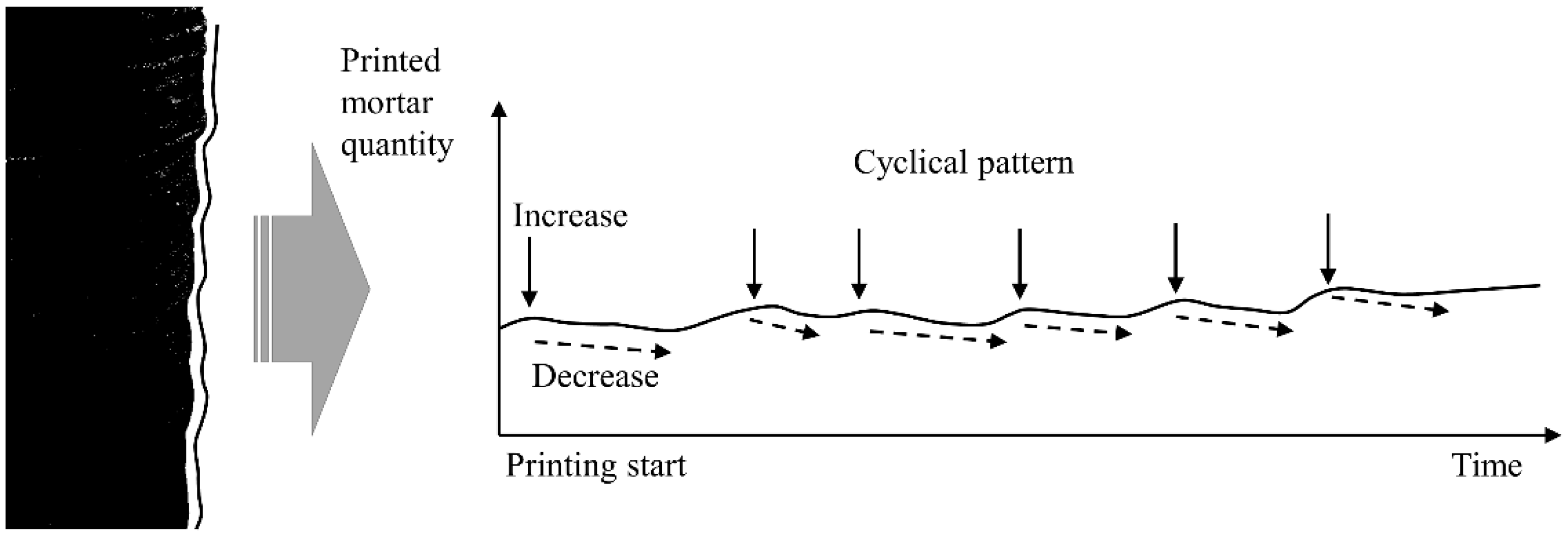
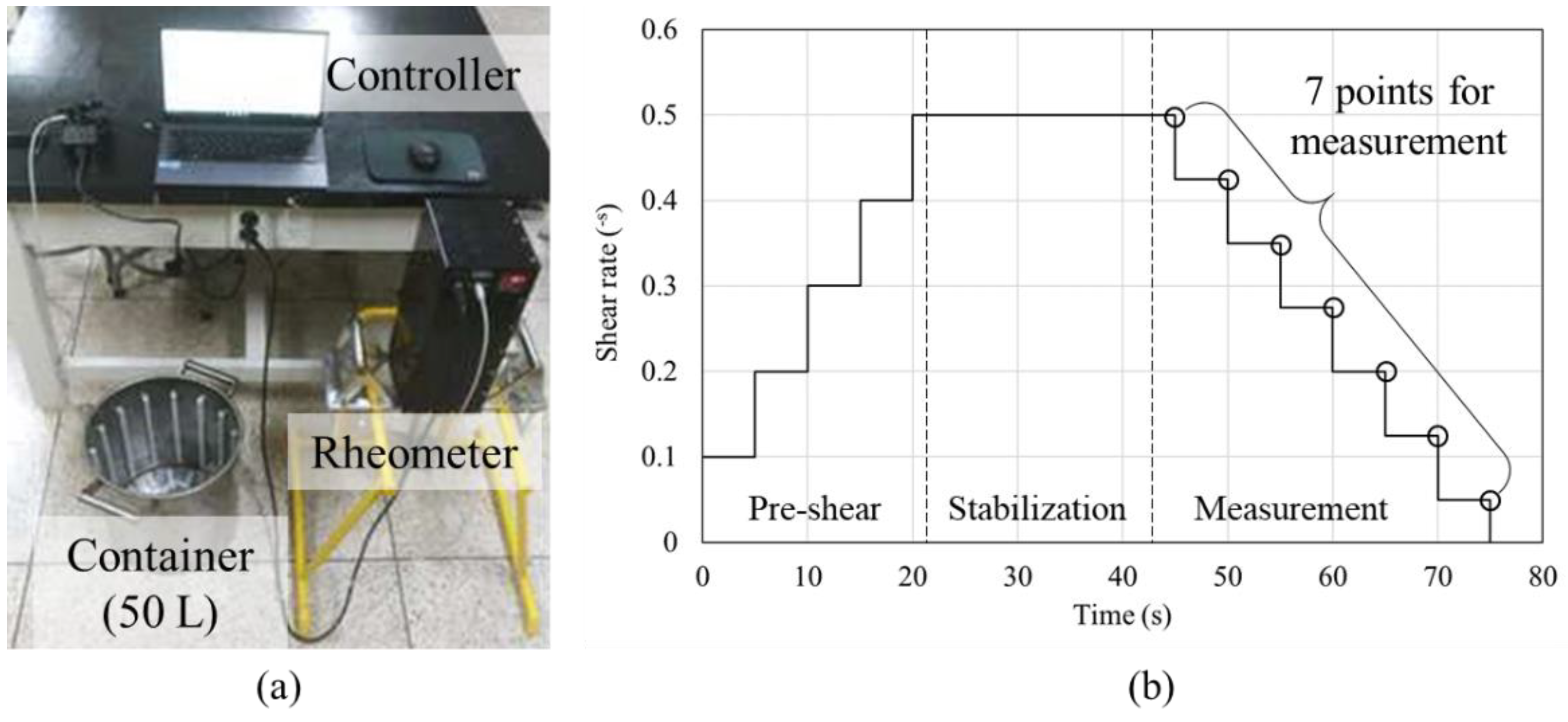

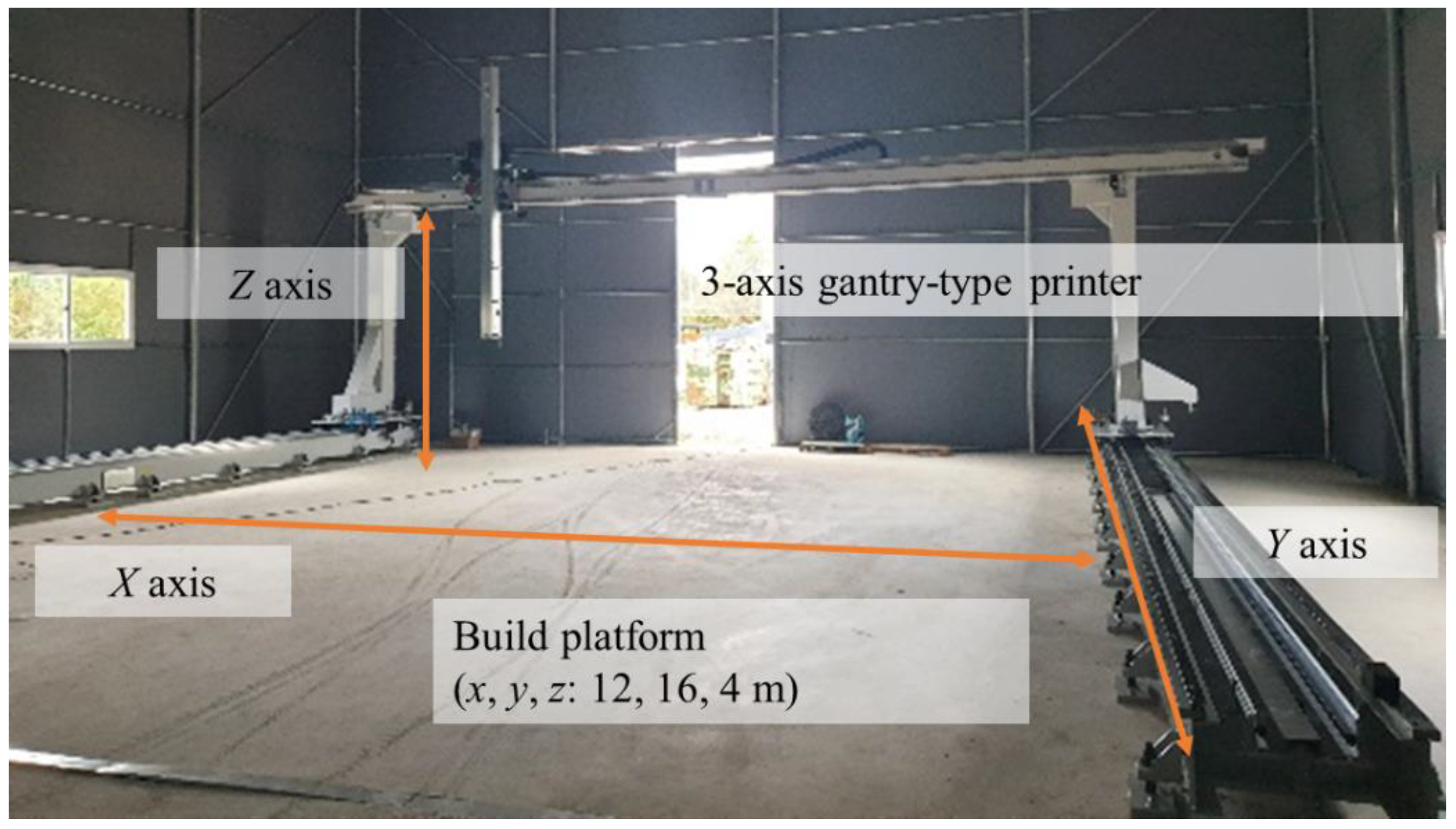

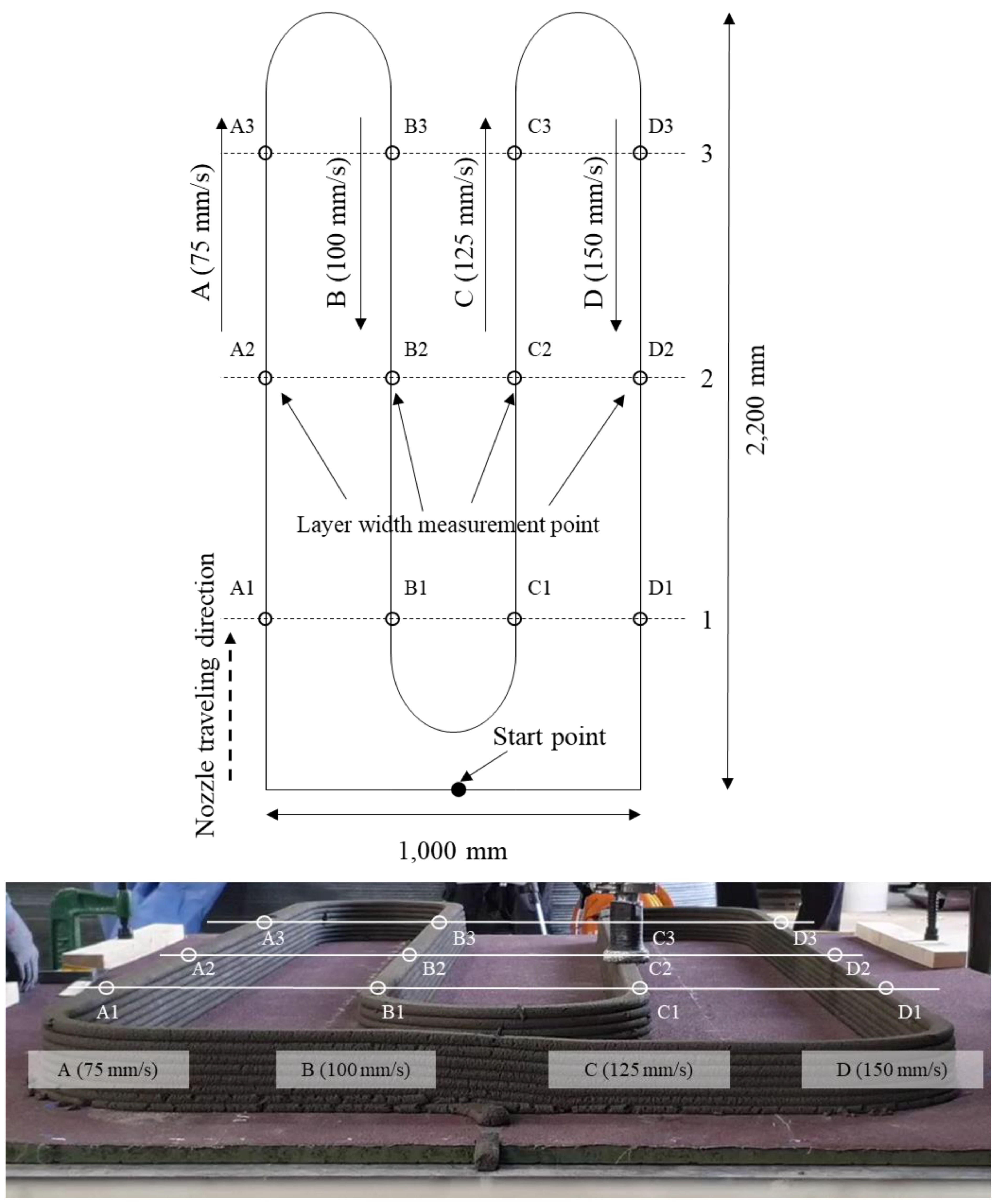

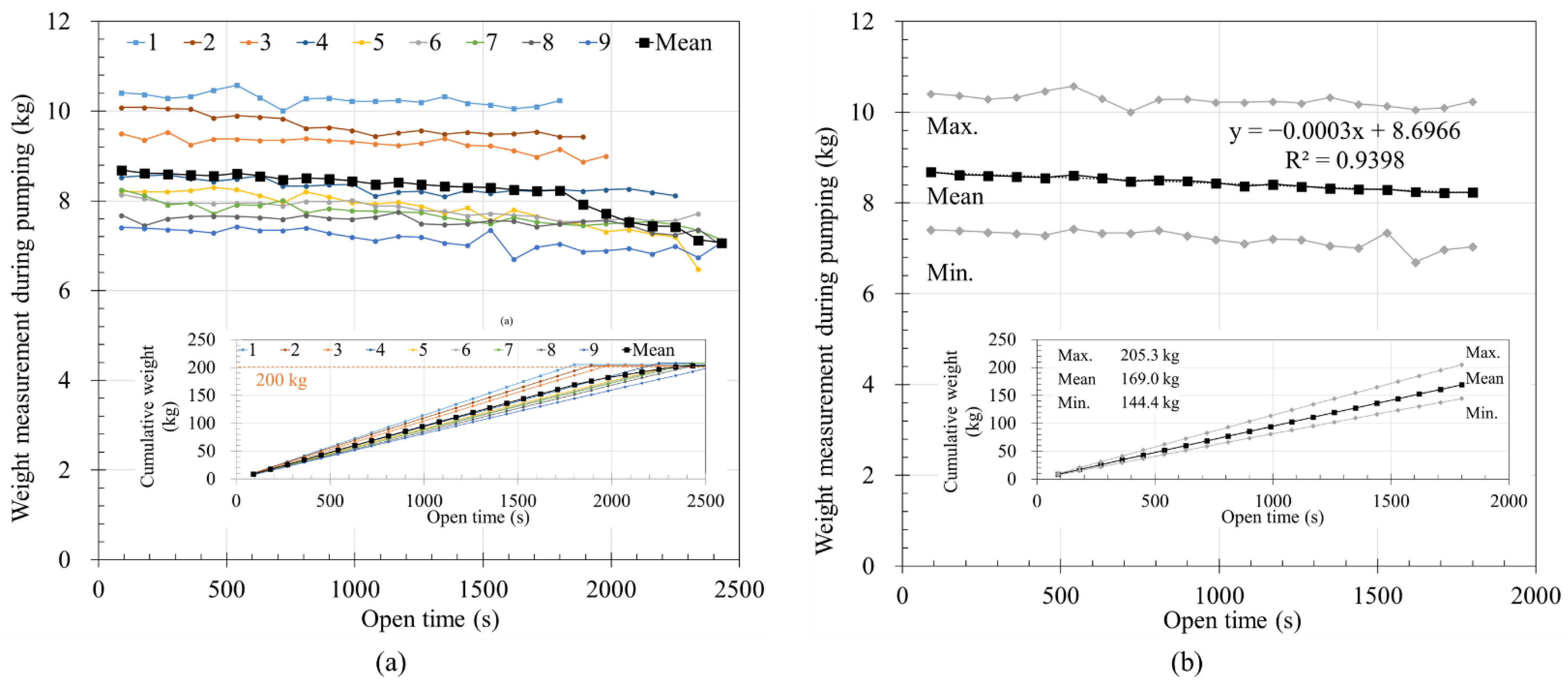


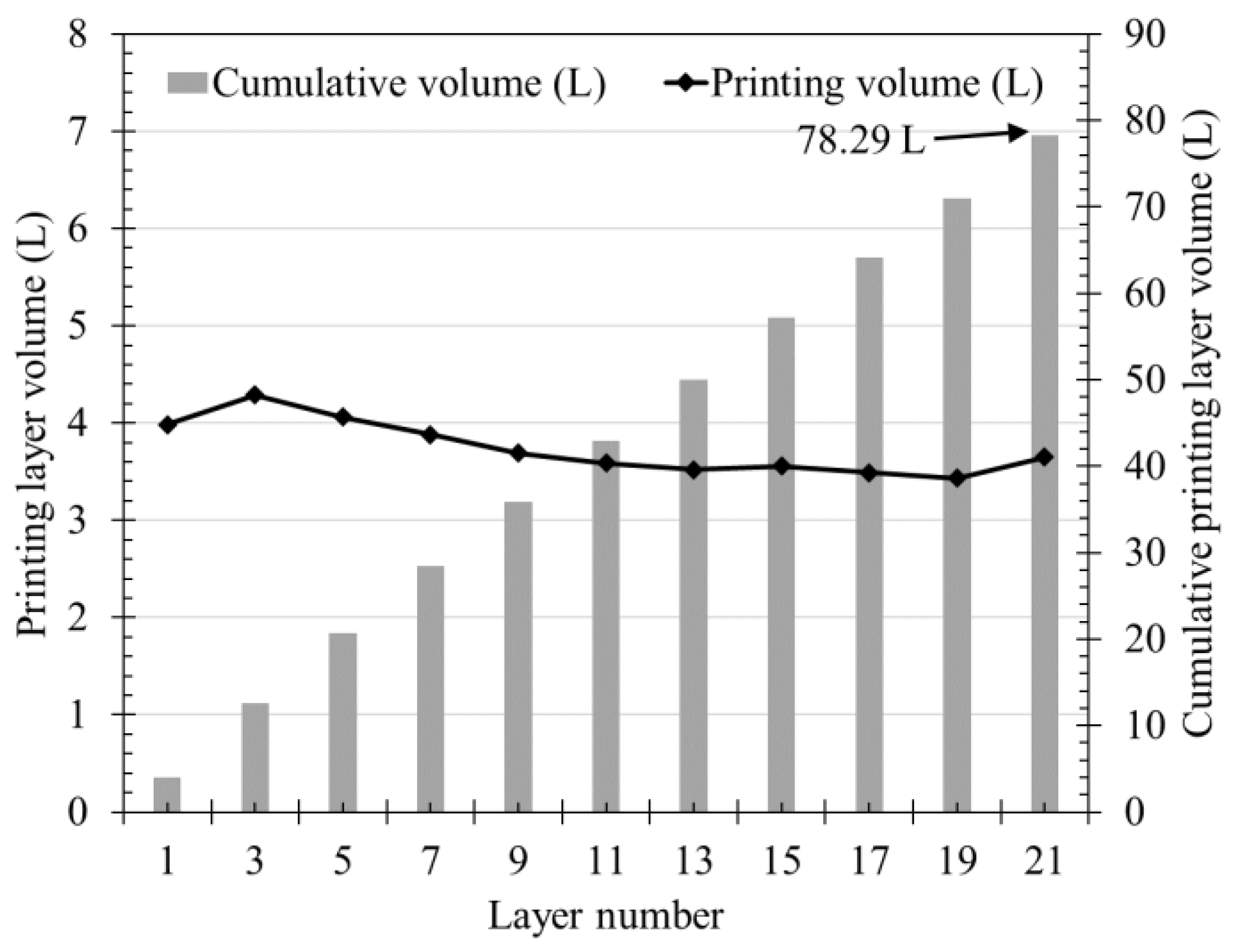
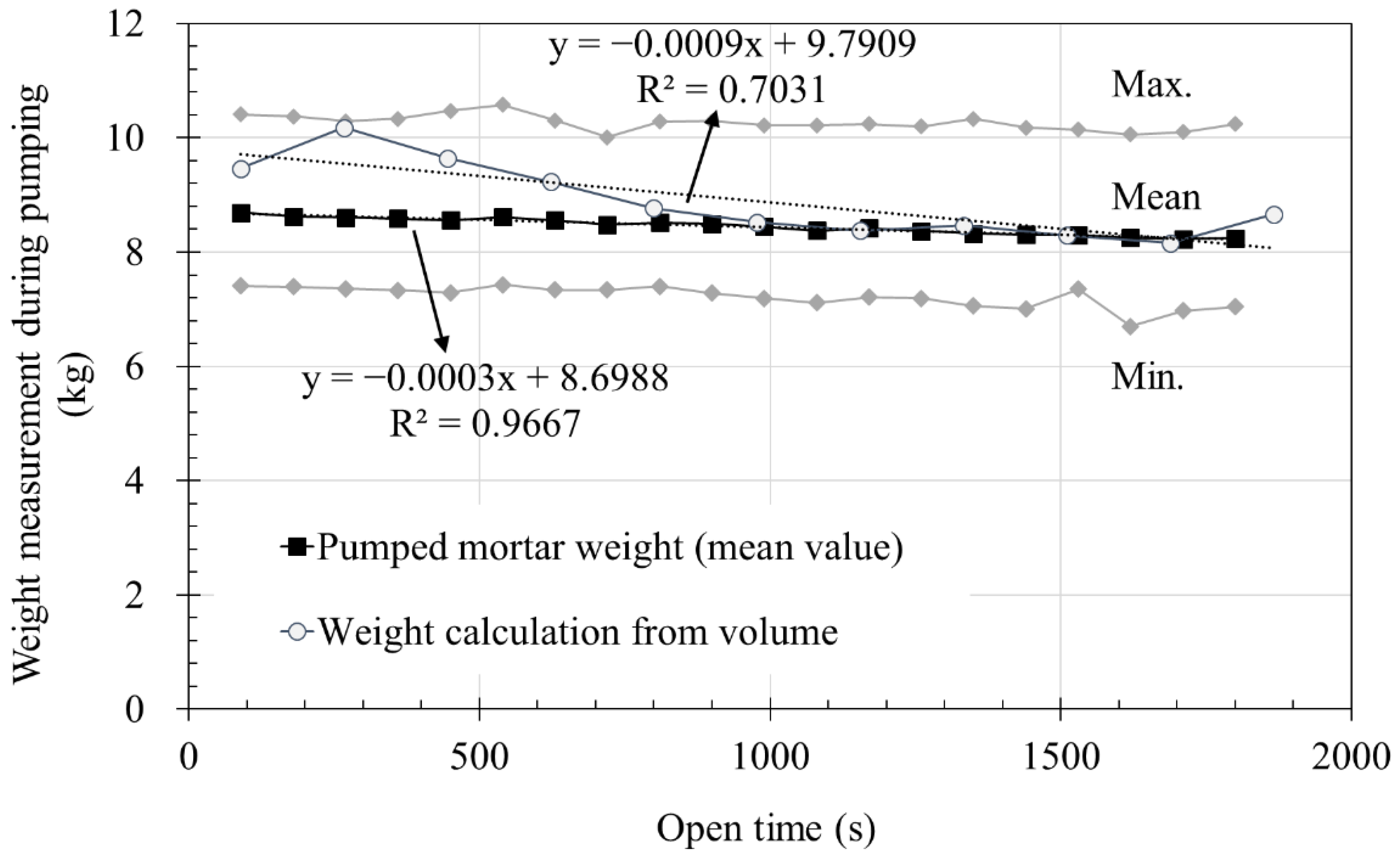
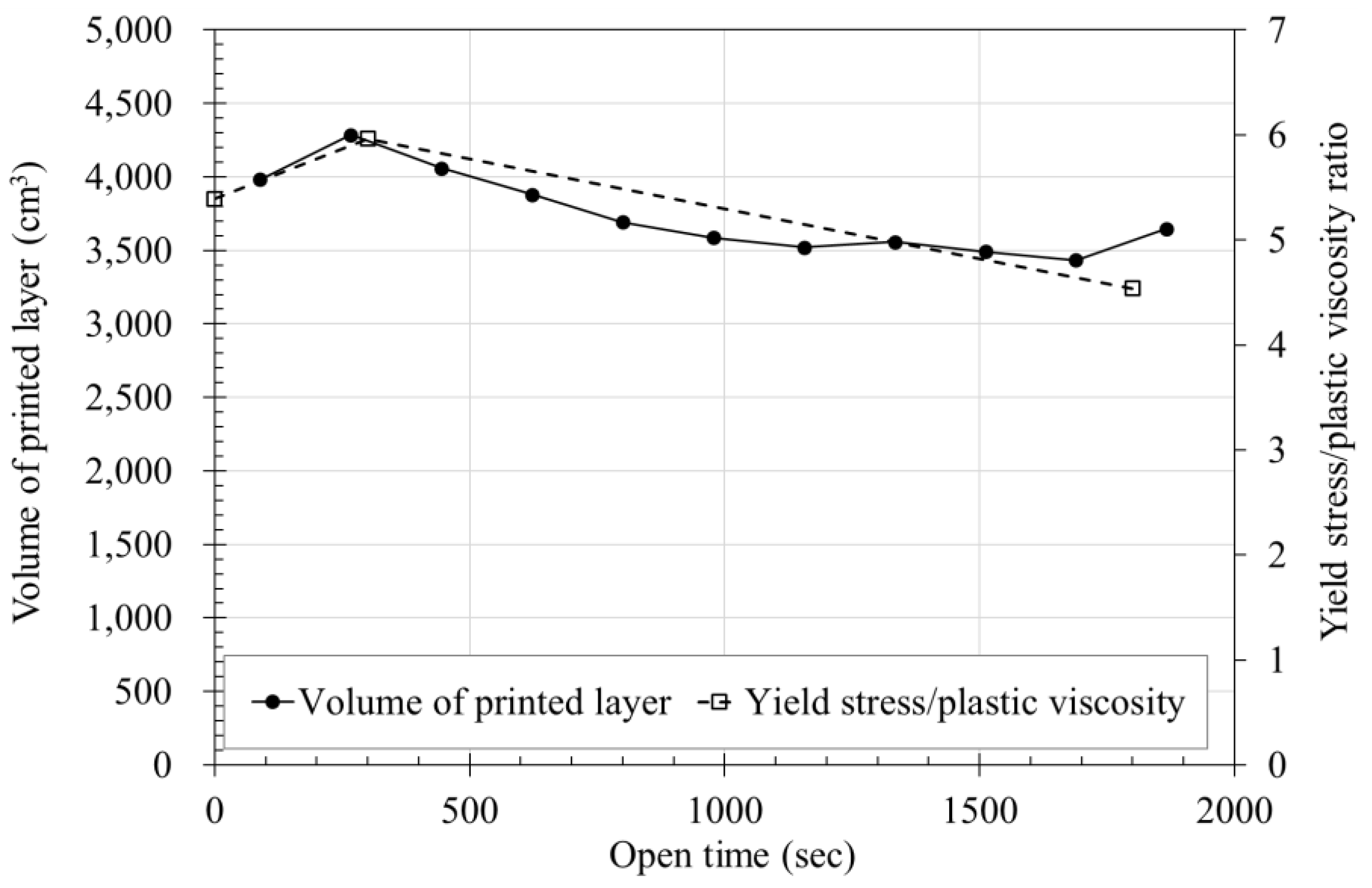
| W/B | Binder | Sand Size | Reference | Year | ||||
|---|---|---|---|---|---|---|---|---|
| OPC | FA | SF | Slag | Special Type | ||||
| 0.16 | ○ | - | ○ | - | - | - | Arunothayan et al. [3] | 2019 |
| 0.24 | ○ | - | ○ | - | - | 0.6, 1.18 mm | Sanjayan et al. [4] | 2021 |
| 0.25 | ○ | ○ | - | - | Calcium aluminate cement | - | Bao et al. [5] | 2018 |
| 0.26 | ○ | ○ | ○ | - | - | - | Wang et al. [6] | 2020 |
| 0.26 | ○ | ○ | ○ | - | - | 0.39 mm | Ma et al. [7] | 2017 |
| 0.28 | ○ | ○ | ○ | - | - | 0.16–0.2 mm | Lee et al. [8] | 2020 |
| 0.28 | ○ | ○ | ○ | - | - | 0–2 mm | Le et al. [2] | 2012 |
| 0.28 | ○ | ○ | - | - | Sulfoaluminate | 0–0.3 mm | Zhu et al. [9] | 2019 |
| 0.3 | ○ | ○ | ○ | - | cement | 0.06–8 mm | Mechtcherine et al. [10] | 2019 |
| 0.31 | ○ | ○ | - | ○ | - | - | Suntharalingam et al. [11] | 2020 |
| 0.32 | ○ | ○ | - | - | - | - | Rahul and Santhanam [12] | 2020 |
| 0.32 | ○ | ○ | ○ | - | - | 0–2 mm | Rahul et al. [13] | 2019 |
| 0.35 | ○ | - | - | - | - | 0–1.2 mm | Xu et al. [14] | 2019 |
| 0.35 | ○ | - | - | - | Calcium sulfoaluminate | 0–2 mm | Khalil et al. [15] | 2017 |
| 0.35 | ○ | - | ○ | - | Nano clay | 0–1 mm | Zhang et al. [16] | 2019 |
| W/B | Water | OPC | FA | SF | Sand | HWRA | VMA |
|---|---|---|---|---|---|---|---|
| 0.28 | 197.50 | 493.74 | 141.07 | 70.53 | 1408.00 | 7.05 | 0.79 |
| Rheological Parameter | Conventional Concrete | Self-Consolidating Concrete | High-Performance Concrete | Ultra High-Performance Concrete | 3DCP Material in This Study |
|---|---|---|---|---|---|
| Yield stress (Pa) | 500–2000 | 5–50 | 50–2000 | 10–100 | 213–445 |
| Plastic viscosity (Pa∙s) | 50–100 | 100–400 | 50–550 | 20–200 | 34–89 |
Publisher’s Note: MDPI stays neutral with regard to jurisdictional claims in published maps and institutional affiliations. |
© 2021 by the authors. Licensee MDPI, Basel, Switzerland. This article is an open access article distributed under the terms and conditions of the Creative Commons Attribution (CC BY) license (https://creativecommons.org/licenses/by/4.0/).
Share and Cite
Lee, H.; Seo, E.-A.; Kim, W.-W.; Moon, J.-H. Experimental Study on Time-Dependent Changes in Rheological Properties and Flow Rate of 3D Concrete Printing Materials. Materials 2021, 14, 6278. https://doi.org/10.3390/ma14216278
Lee H, Seo E-A, Kim W-W, Moon J-H. Experimental Study on Time-Dependent Changes in Rheological Properties and Flow Rate of 3D Concrete Printing Materials. Materials. 2021; 14(21):6278. https://doi.org/10.3390/ma14216278
Chicago/Turabian StyleLee, Hojae, Eun-A Seo, Won-Woo Kim, and Jae-Heum Moon. 2021. "Experimental Study on Time-Dependent Changes in Rheological Properties and Flow Rate of 3D Concrete Printing Materials" Materials 14, no. 21: 6278. https://doi.org/10.3390/ma14216278





